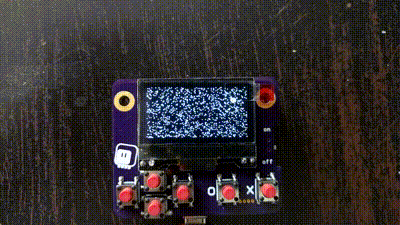Advanced Spriting¶
Published on 2018-01-09 in Micro:Boy.
After a nightfull of sleep, I realized that I don’t need a separate method with “or” for proper non-transparent sprites, since if I’m masking the place with black anyways, “xor” works just as well. As an added bonus, I can have also parts of the sprite sticking out of the mask outline, which then will be xor-ed, which could be a nice effect. I also decided to use “nand” for the mask, not “and”, since then the outline of the sprite is white and the background is black, and that works better with the shifting operators. Finally, I made the mask just an optional argument to the blit function, since you are not likely to use it alone. So I have this:

I had to add one more thing, of which I didn’t think before. When not using “xor” for the sprite, I need some way to restore the previous background when the sprite moves away. Right now I’m using an inefficient method of simply keeping a copy of the background in a separate buffer, and simply copying the few bytes where the sprite used to be from it to the actual frame buffer (and updating the dirty numbers accordingly). A more efficient way could be imagined.
———- more ———-Anyways, the new code looks like this:
def blit(self, x, y, data, mask=b''):
if not -8 < x < 128:
return
if x < 0:
data = data[-x:]
x = 0
elif x > 120:
data = data[:120 - x]
page = y // 8
shift = y % 8
if 0 <= page <= 7:
index = x + 128 * page
for byte in mask:
self.buffer[index] &= ~(byte << shift)
index += 1
index = x + 128 * page
for byte in data:
self.buffer[index] ^= byte << shift
index += 1
self.dirty_min[page] = min(self.dirty_min[page], x)
self.dirty_max[page] = max(self.dirty_max[page], x + 8)
page += 1
if 0 <= page <= 7 and shift:
shift = 8 - shift
index = x + 128 * page
for byte in mask:
self.buffer[index] &= ~(byte >> shift)
index += 1
index = x + 128 * page
for byte in data:
self.buffer[index] ^= byte >> shift
index += 1
self.dirty_min[page] = min(self.dirty_min[page], x)
self.dirty_max[page] = max(self.dirty_max[page], x + 8)
def clear(self, x, y, background):
buf = self.buffer
for page in (y // 8, y // 8 + 1):
if page > 7:
break
index = x + 128 * page
for i in range(8):
buf[index] = background[index]
index += 1
self.dirty_min[page] = min(self.dirty_min[page], x)
self.dirty_max[page] = max(self.dirty_max[page], x + 8)
I still need to work on making the clear function more robust, so that you can use it with coordinates outside of the screen.
 deshipu.art
deshipu.art